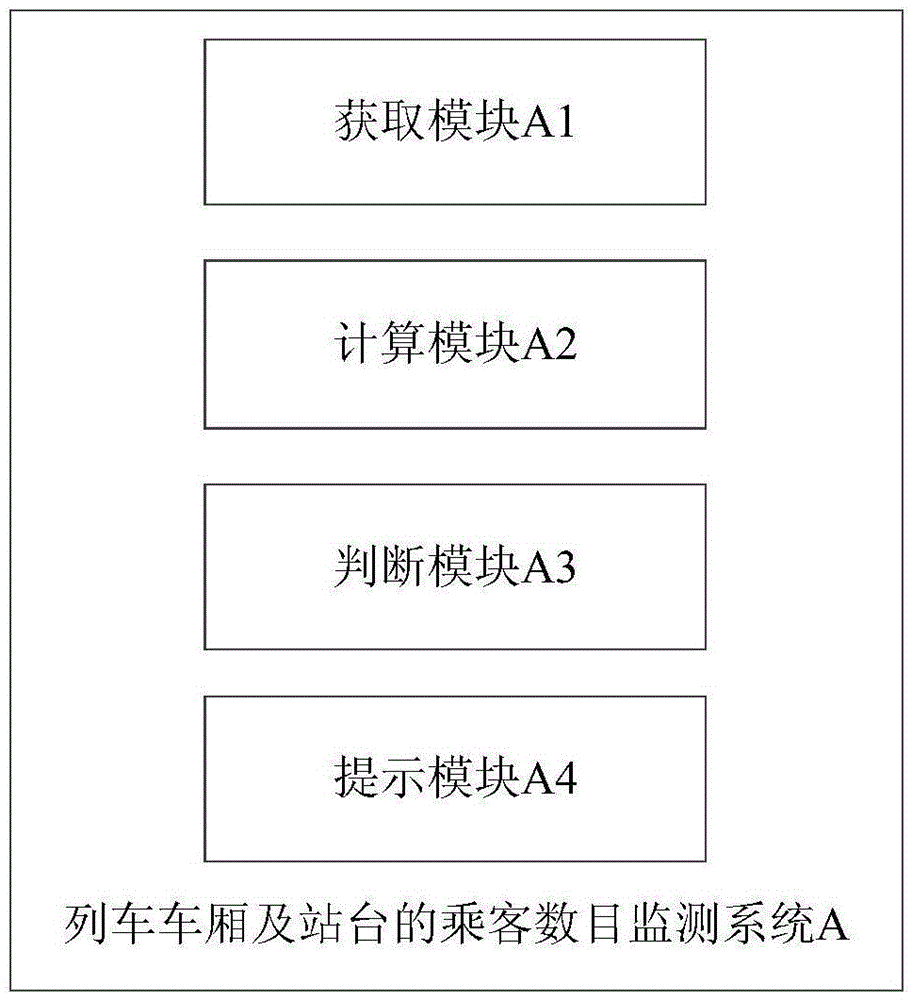Method and system for monitoring number of passengers in train compartments and number of passengers on platform
A monitoring system and passenger technology, applied in passenger warning devices, transportation and packaging, railway car body parts, etc. Effect
- Summary
- Abstract
- Description
- Claims
- Application Information
AI Technical Summary
Problems solved by technology
Method used
Image
Examples
Embodiment 1
[0032] figure 1 It is a flow chart of the method for monitoring the number of passengers in train carriages and platforms provided in this embodiment, see figure 1 , the passenger number monitoring method of this train carriage and platform comprises:
[0033] Step S1: Obtain the maximum number of first passengers accommodated in each car of the train entering the preset station, the second number of passengers currently accommodated in each car, the number of passengers to be accommodated in each car in the preset Set the third number of passengers getting off at the station and the fourth number of passengers waiting for boarding in each platform area corresponding to each compartment on the preset station;
[0034] Step S2: Calculate the first difference between the first number of passengers and the second number of passengers in each car, and the sum of the first difference and the third number of passengers in the car to obtain the arrival of the car at the preset stati...
Embodiment 2
[0043] On the basis of Embodiment 1, this embodiment provides a method for obtaining the third number of passengers and the fourth number of passengers. Specifically: Step S1 includes:
[0044] Obtain the maximum number of first passengers accommodated in each car of the train entering the preset station, the second number of passengers currently accommodated in each car, and the number of passengers in each car that are about to arrive at the preset station. A third number of passengers with opened compartment doors and a fourth number of passengers facing the platform doors in each platform area corresponding to each compartment at the preset station.
[0045] As in the method described in Embodiment 1, the camera installed in the compartment can be used to obtain the third number of passengers who will get off at the preset station, and the camera installed near the platform door in the platform area can be used to obtain the fourth number of passengers waiting to get on th...
Embodiment 3
[0049] On the basis of embodiment 2, step S1 includes:
[0050] Judging whether the distance between the train and the preset station is less than a preset distance, and if so, obtaining the first number of passengers, the second number of passengers, the third number of passengers, and the fourth number of passengers.
[0051] The consideration of the preset distance is to ensure that the calculated results are closer to reality and improve the accuracy of the results. However, the setting of the preset distance also needs to consider the time it takes passengers to select and change platforms. A reasonable preset distance needs to consider both factors at the same time.
[0052] When the distance between the train and the station to be reached is less than the preset distance, that is, when the train is about to enter the station, the third number of passengers and the fourth number of passengers are obtained, and the number of passengers in the train carriage and platform ...
PUM
 Login to View More
Login to View More Abstract
Description
Claims
Application Information
 Login to View More
Login to View More - R&D
- Intellectual Property
- Life Sciences
- Materials
- Tech Scout
- Unparalleled Data Quality
- Higher Quality Content
- 60% Fewer Hallucinations
Browse by: Latest US Patents, China's latest patents, Technical Efficacy Thesaurus, Application Domain, Technology Topic, Popular Technical Reports.
© 2025 PatSnap. All rights reserved.Legal|Privacy policy|Modern Slavery Act Transparency Statement|Sitemap|About US| Contact US: help@patsnap.com


